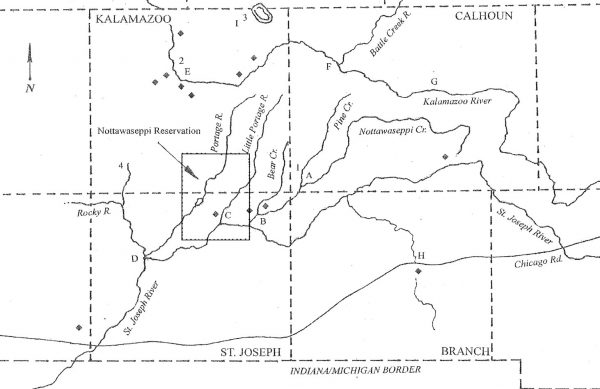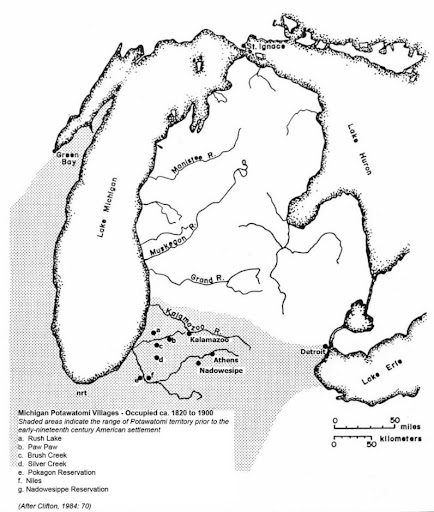Figure 21. Michigan Treaties. Reprinted from “People of the Three Fires: The Ottawa, Potawatomi, and Ojibway of Michigan,” by J. Clifton, G. Cornell, and J. McClurken, 1986, p. 36.
The Potawatomi signed the first Treaty of Chicago on August 29th, 1821, ceding much of their remaining land to the U.S. Federal Government (Rodwan & Anewishki, 2009, p. 6). Similar to the 1807 Treaty of Detroit, this treaty impacted the band of Huron Potawatomi. Most settled on a four-mile square tract of land reserved under this 1821 treaty that was known as the “Nottawaseppi Reservation [located] on the banks of the St. Joseph River in what is now St. Joseph County’s Mendon area” (Rodwan & Anewishki, 2009, p. 6; Summary Under the Criteria and Evidence for Proposed Finding Huron Potawatomi, Inc., 1995, p. 9). Other Huron Potawatomi bands retained land reservations at what is now Coldwater, Michigan, or continued to reside on land reserved in the 1807 Treaty of Detroit.
The 1821 Treaty of Chicago ceded to the United States lands in the Michigan Territory south of the Grand River and west of what is now Jackson, Michigan, except for several small reservations. Also ceded was an easement between Detroit and Chicago running through Indiana and Illinois, which wrapped around the southern coast of Lake Michigan (Summary Under the Criteria and Evidence for Proposed Finding Huron Potawatomi, Inc., 1995, p. 260). Many individual Chiefs and prominent leaders of Potawatomi bands were also permitted to retain tracts of lands for themselves or their children.
As they had in other Treaties, the Huron Potawatomi and other parties to the 1821 Treaty of Chicago also reserved the continued right to hunt on the lands they had ceded to the United States under the same terms as those retained in the 1795 Greenville Treaty.

Figure 22. The Nottawaseppi Reservation. Reprinted from “NHBP History Book: A People in Progress,” by J. Rodwan and V. Anewishki, 2009.
The Huron Potawatomi likely “migrated from the Huron River to the Nottawasippe Prairie between 1815 and 1821 and Moguago II [future Chief John Moguago’s father] established a village which contained 30 or 40 huts on the Nottawa-Sippe Creek, [which was located] west of present-day Leonidas, Michigan” (Summary Under the Criteria and Evidence for Proposed Finding Huron Potawatomi, Inc., 1995, p. 250).
At this point, the “Nottawaseppi” designation was added to the Huron Potawatomi. The word “Nottawasippee” is an Anishnabek ethnic slur meaning “like rattlesnakes,” which referred to the Huron people who inhabited the area before the arrival of the Potawatomi (Picor, n.d.)
Despite this name, the band had no direct connection with the unrelated Huron (Wyandot) people; instead, both “Nottawaseppi” and “Huron” refer to the band’s historical location along what is now known as the Clinton River in southeastern Michigan. The Clinton River was formerly known as the “Nottawasippee River,” the “Huron River of St. Clair,” and the “River Huron” (Gibb, 2013, p.1).
References:
Gibb, T. (2013). Child of the ice age: The Clinton River. Michigan State University Extension. https://www.canr.msu.edu/news/child_of_the_ice_age_the_clinton_river
Picor, G. (n.d.).
Rodwan, J., & Anewishki, V. (2009). NHBP History Book: A People in Progress. Nottawaseppi Huron Band of the Potawatomi Environmental Department.
Ratified Indian Treaty 117: Ottawa, Chippewa and Potawatomi—Chicago, August 29, 1821 (Indian Treaties, 1789-1869). (1821). U.S. Government; General Records of the United States Government, Record Group 11. https://digitreaties.org/treaties/treaty/100378017/
United States, Department of the Interior, Bureau of Indian Affairs Branch of Acknowledgement and Research, et al. “Summary Under the Criteria and Evidence for Proposed Finding Huron Potawatomi, Inc.” HPI-V001-D004, https://www.bia.gov/sites/bia.gov/files/assets/as-ia/ofa/petition/009_hurpot_MI/009_pf.pdf.

